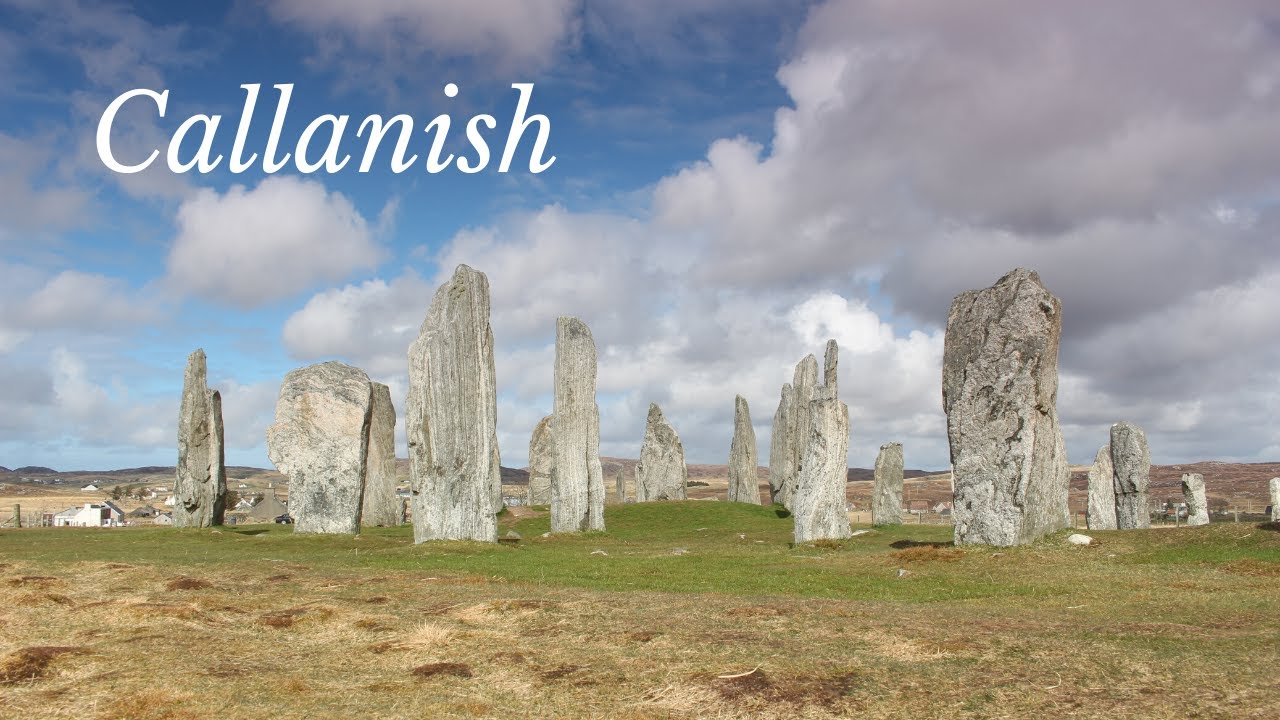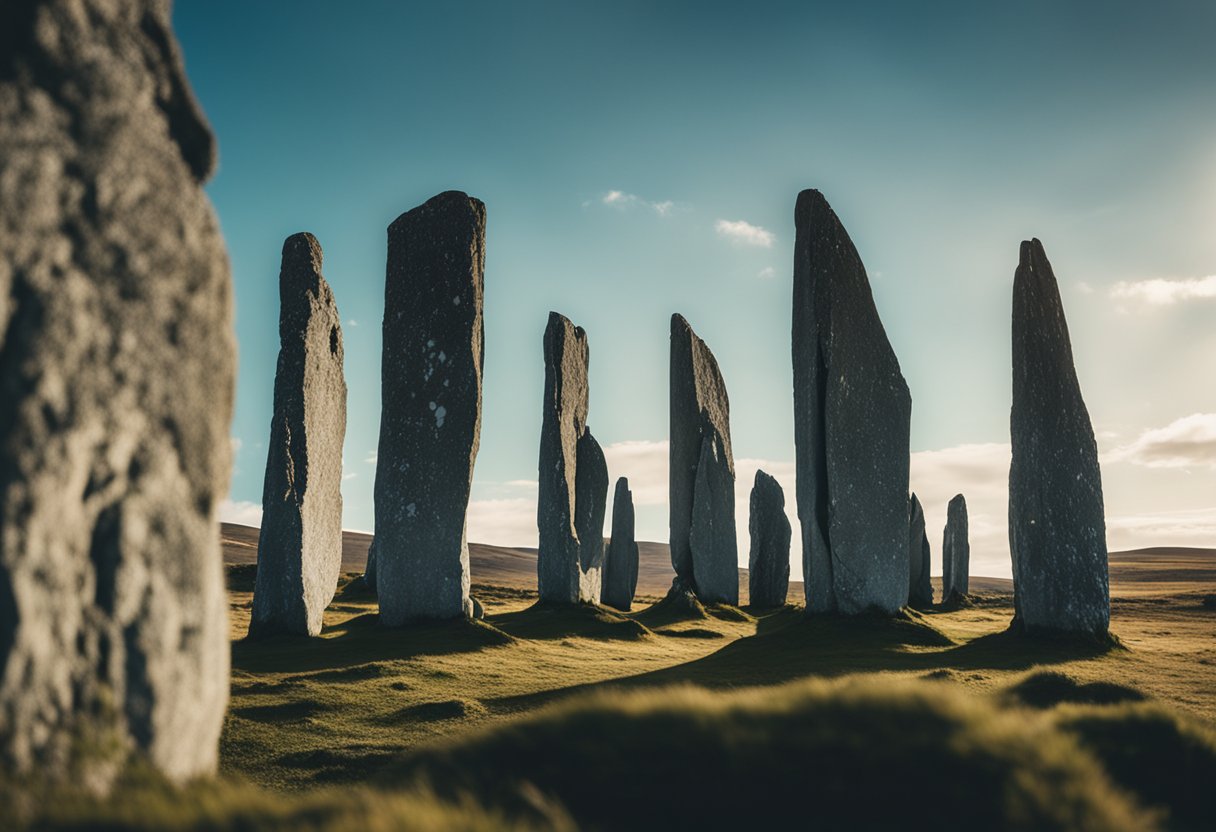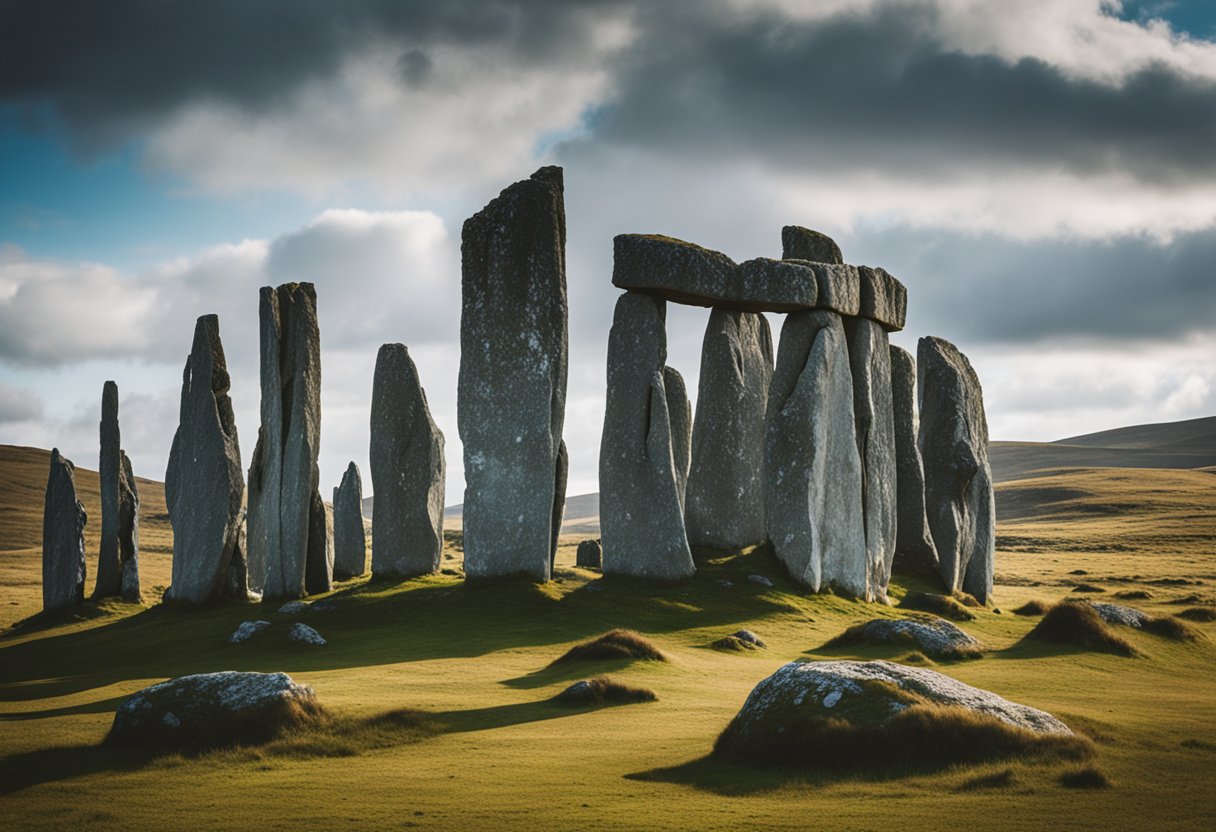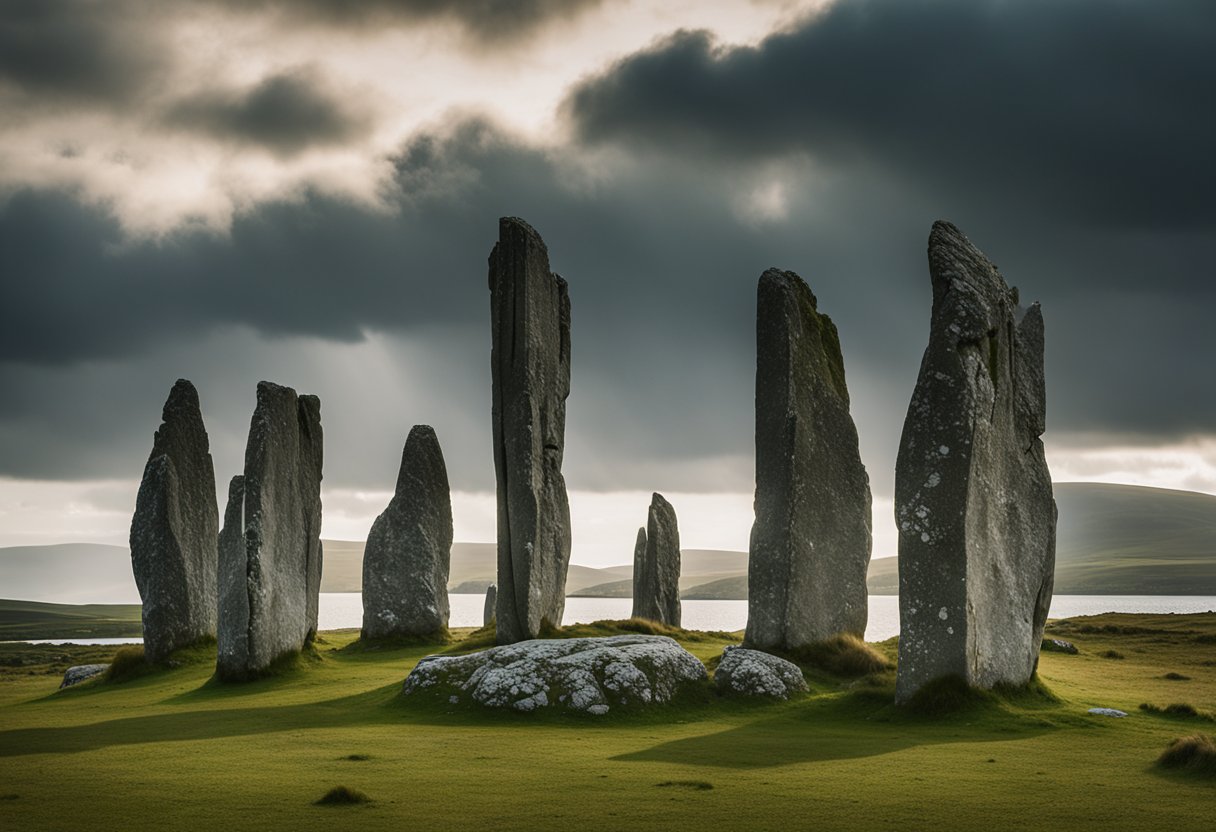Callanish Stones: Scotland’s Prehistoric Marvel Unveiled

Updated On: April 23, 2024 by Eman Sameh
Steeped in mystery and grandeur, the Callanish Stones are a remarkable stone formation on the Isle of Lewis in Scotland’s Outer Hebrides. These enigmatic standing stones, erected more than 5,000 years ago, fan out in a distinctive cross shape reminiscent of a Celtic cross. More than a mere curiosity, they hold a mirror to Scotland’s rich Neolithic heritage, serving as a poignant reminder of the region’s storied past.

Often referred to as Scotland’s answer to Stonehenge, the Callanish Stones predate their more famous southern counterpart, giving us a glimpse into the sophisticated and enigmatic civilisation that created them. Their precise purpose continues to elude historians and archaeologists, yet the stones’ alignment with the cycles of the moon suggests an astronomical significance, casting these ancient megaliths as a prehistoric observatory against the backdrop of the wild Scottish landscape. The Callanish Stones are an archaeological treasure and deeply interwoven with local folklore, underscoring their cultural and spiritual importance to the surrounding community.
History of Callanish Stones
Exploring Scotland’s Neolithic heritage brings us to the enigmatic Calanais Standing Stones on the Isle of Lewis. These ancient sentinels are a testament to the site’s early history and ceremonial significance.
Neolithic Era and Early History
The call to unveil the mysteries of the Calanais Standing Stones beckons us to the Neolithic period, a time defined by the transition from nomadic lifestyles to settled farming communities. The construction of these megalithic structures dates from between 2900 and 2600 BC, predating the main circle at Stonehenge in England. During this era, the site became an epicentre for ritualistic practice, indicating a complex and organised society capable of such an architectural undertaking.
Excavations at Calanais have suggested prolonged ceremonial use, spanning potentially 2000 years, before becoming enveloped by peat between 1000 and 500 BC. These stones stand as a historical chronicle, from their erection by Neolithic peoples to their gradual submergence into obscurity. They give us profound insights into our ancestors’ spiritual and communal life.
Our journey through the annals of prehistoric Scotland is not solely an academic endeavour; it is a passage across millennia, bringing us face-to-face with the enduring legacy of the land and its early inhabitants.
Unveiling the Callanish Stones
Intriguing and steeped in mystery, the Callanish Stones on the Isle of Lewis are a remarkable testament to Scotland’s Neolithic past. We shall explore the discovery and subsequent excavations that have revealed much about this ancient site, as well as the artefacts uncovered, which continue to puzzle archaeologists.
Discovery and Excavations
Historic Environment Scotland details that the Callanish Stones were revealed to the modern world when peat cutting in the 19th century exposed the tips of the buried stones—over time, peat had built up around the stones, hiding them from view. Archaeological interest grew, giving rise to formal excavations. Notably, archaeologist Patrick Ashmore conducted thorough research in the 1980s, adding significantly to our understanding of this incredible site. Despite these efforts, several secrets of the Callanish Stones lie beneath the surface, veiled by the passage of time.
Artefacts and Findings
Throughout the various archaeological endeavours at Callanish, a small number of artefacts have been discovered. Pottery shards and tools found during these excavations offer us a glimpse into the lives of the Neolithic peoples who erected these stones. Sadly, much like their counterparts at Stonehenge, there’s a scarcity of artefacts that could tell us more about the stones’ purpose and the exact nature of the activities that took place around them. However, each unearthed artefact adds a crucial piece to the puzzle, enabling us to weave a richer tapestry of the history of Lewis.
Description of the Monument
We shall explore the Callanish Stones, a prehistoric marvel that has withstood the test of time and provides us with a glimpse into our ancient past. This Stonehenge-like arrangement on the Isles not only captivates visitors with its mystique but also stands as a testament to the ingenuity of Neolithic society.
Physical Structure and Composition
The Callanish Stones form a significant stone circle consisting of thirteen stones, with an imposing monolith near its heart. The central stone stands at a height of around 4.8 metres. The entire monument is constructed from Lewisian gneiss, one of the oldest rock types in Scotland, underlying the intrinsic connection between the monument and its ancient landscape.
Surrounding the central circle are rows of smaller stones, creating an avenue that stretches to the north-northeast. A chambered tomb lies within the circle, indicating that the site may have been used for burial rituals. Discover more about the monument’s layout at the Historic Environment Scotland website.
Surrounding Geography
The Calanais Standing Stones are dramatically located on the west coast of Lewis in the Outer Hebrides, Scotland. The site overlooks a landscape replete with rolling hills and bodies of water, an impactful juxtaposition to the man-made wonder of the stones. The rough terrain and open skies create an atmosphere that enhances the solemn grandeur of the site.
The site’s wild and rugged location also allows an intimate interaction with the ancient Scottish environment. Visiting the stones offers more than just historical appreciation; it’s an immersive experience of the raw beauty of Scotland’s natural geography. For a more detailed account of the setting, one can visit Wilderness Scotland.
Astronomical Significance
The Callanish Stones are renowned for their precise arrangement, hinting at ancient understanding of celestial patterns.
Alignment and Observations
The Callanish Stones, an impressive megalithic site on the Isle of Lewis, Scotland, signify more than mere stones rising from the ground; they are a testament to Neolithic ingenuity and astronomical precision. It is evident that the stones served as an astronomical observatory; their positioning aligns with key celestial events, particularly the moon and the sun’s movements.
The primary stone formation is orientated towards the midsummer sunset and the midwinter sunrise, marking the winter solstice. During certain periods, the moon skims low over the horizon, observable at the site in a phenomenon known as the “Moonstand”. This intriguing lunar alignment further suggests that the site might have been used as a celestial calendar by Neolithic peoples, monitoring seasons and crafting a structured comprehension of time year-round.
Illusive and enchanting, the northern lights also play into the landscape of Callanish, providing a dramatic backdrop that would have influenced Neolithic consciousness and may have been intertwined with the site’s celestial observances. Whether marking time for practical purposes or ceremonial, the stones’ alignments present a captivating narrative of early astronomical observation and sophistication.
Cultural and Spiritual Importance
The Callanish Standing Stones are not just an impressive sight but a deep well of cultural and spiritual significance. These ancient monoliths are embedded with a history of ceremonies and legends that resonate with the spirits of our past.
Rituals and Ceremonies
It is widely believed that the Callanish Standing Stones were a centre for ritual activity dating back centuries. The cruciform pattern of the stones suggests a designed space for ceremonies, with alignments that are considered significant for astronomical observations. Gaelic tradition named this place urras nan tursachan, hinting at its ceremonial importance. Nestled in the moors of Lewis in the Outer Hebrides, the stones hold stories of prehistoric gatherings, possibly linked to lunar cycles and solstices. Such activities would highlight the Gaelic community’s connection with the land and the skies.
Lore and Legends
Steeped in legends and lore, the Callanish Stones whisper tales from a time long before the arrival of Christianity in Scotland. Local legends speak of giants who refused to be converted to Christianity, turning to stone as a result. Some lore recounts that the stones are petrified entities, forever captured in the limbo between the earth and the divine. These narratives have been passed down through generations, enriching the oral history of Lewis and the Outer Hebrides and painting a picture of a landscape where the threshold between the natural and the supernatural seems remarkably thin.
Comparison with Other Megaliths

Exploring the Callanish Stones offers us a glimpse into the Neolithic mind, revealing how these ancient architects mirrored and differentiated their creations from other similar structures. Let’s evaluate the similarities with Stonehenge and the distinctive features that set the Callanish Stones apart.
Similarities with Stonehenge
The Callanish Stones, Tursachan Chalanais, and Stonehenge are iconic Neolithic monuments that have fired our collective imagination. They are testaments to the prehistoric era’s accomplishments in the British Isles. Most notably, they are both stone circles with astronomical alignments, suggesting a level of sophisticated understanding of celestial events by the societies erecting them.
Distinctive Features
While similar in purpose and time, the Callanish Stones possess unique characteristics. Unlike the circular layout of Stonehenge, the Callanish Stones are laid out in a cruciform pattern, with rows of monoliths radiating outwards. Strikingly, there is a chambered tomb at the heart of Callanish, pointing to differences in ceremonial or religious use when compared with Stonehenge’s design. Further differentiating the two, the Isle of Lewis, home to the Callanish Stones, provides a markedly different setting—a windswept, coastal landscape that starkly contrasts with Stonehenge’s rolling Salisbury Plain.
Tourism and Visitor Experience

We are delighted to share that the Callanish Stones provide a unique and engaging experience for visitors, encapsulating the allure and mystery of ancient Scotland. Whether you’re an avid fan of historical monuments or the enchanted beauty depicted in series like Outlander, Callanish offers a remarkable journey back in time.
Access and Facilities
When you arrive at the visitor centre, you’ll find it equipped with the essentials for a comfortable visit, including parking spaces. Planning your journey is straightforward – whether by car, taking a scenic route across the Isle of Lewis, or by public transport with connections in Stornoway. If coming from the mainland, flights and ferries are available to the island, providing a seamless travel experience. At the site, we ensure that the facilities are well-matched to the requirements of an international audience keen to explore this historic gem.
Walking and Exploration
The landscape around Callanish is profoundly moving, with a ridge offering expansive views of the surrounding area. We advise taking a leisurely walk to fully appreciate the magnitude of the standing stones and the complex comprised of a cross shape with a central circle. Please wear suitable footwear and be prepared for changeable weather – a common feature of the Scottish climate. Each step around this archaeological treasure trove brings alive the history and legends of the past, creating an immersive and unforgettable experience.
Impact on Local Community
The Callanish Stones not only stand as a prehistoric wonder but also leave a significant mark on the local community through both economic and cultural avenues.
Economic Benefits
The village of Callanish, situated on the Isle of Lewis, experiences a consistent influx of visitors drawn to the enigmatic allure of the Callanish Stones. This directly translates to economic benefits for the community. Local businesses, such as the Calanais Visitor Centre and the nearby Blackhouse Village, thrive as tourism increases demand for hospitality, crafts, and guided tours. In addition, Berneray, a part of the locale, often sees visitors who, after exploring the stones, are inclined to delve into other attractions, further supporting the local economy.
Cultural Contributions
Culturally, the Callanish Stones foster a profound connection to the area’s heritage. They serve as a focal point for music, with performances and events often held against the backdrop of these ancient sentinels. The Isle of Lewis itself, steeped in tradition, is defined by a strong sense of community where the stones play a crucial role in local identity. Cultural events surrounding the stones attract visitors and offer the Lewis community an opportunity to showcase and sustain their unique customs and festivities.
Conservation Efforts
The survival of the Callanish Stones through the ages is a testament to our dedication to preserving such invaluable heritage sites. Our efforts ensure that these ancient megaliths continue to stand as a symbol of the past for future generations.
Preservation Initiatives
The Callanish Stones, including Callanish III, are under our attentive care to prevent degradation and to manage the natural and human impacts. We employ various conservation techniques, such as:
- Regular monitoring for weathering effects
- Maintaining vegetation to avoid root damage
- Providing pathways for visitors to minimise direct contact
Historic Environment Scotland oversees these efforts, ensuring that the integrity of the site’s structure and its historical significance are upheld.
Legal and Societal Roles
Our responsibility extends beyond physical upkeep. With a legal framework set in place, we ensure:
- The protection of the site as a Scheduled Monument
- The enforcement of policies to safeguard the stones against vandalism or inappropriate use
We engage with local communities, fostering a sense of ownership and pride in this part of our shared heritage. Through education and awareness programs, we ensure societal participation in preserving the legacy of the Callanish Stones for years to come.
Influence on Popular Culture

We recognise the Callanish Stones as more than just a prehistoric site; their presence has resonated through popular culture, appearing in various forms of literature and media and inspiring fictional portrayals that captivate the imagination.
Literature and Media
The Callanish Stones have featured in various works that span genres, from travelogues to in-depth studies. Notably, they appear within the visual fabric of the TV series Outlander, based on the novels by Diana Gabaldon. These ancient monoliths serve a critical function in the story, acting as a conduit for the series’ time-travelling narratives.
Callanish in Fiction
In the realm of fiction, the stones are often enveloped in a mystical aura. For instance, Diana Gabaldon’s Outlander series uses the stones as a pivotal plot element, providing a portal for the protagonist to traverse centuries. The standing stones’ awe-inspiring silhouette and the ethereal quality they bestow upon the story illustrate their enduring influence in books and beyond, sparking curiosity and speculation about their true purpose and history.
Frequently Asked Questions
In this section, we’ll answer some of the most common queries about the Callanish Stones, which are often considered Scotland’s counterpart to the famed Stonehenge.
How do the Callanish Stones compare to Stonehenge in terms of historical significance?
While Stonehenge is arguably more famous globally, the Callanish Stones hold comparable historical significance. These megalithic structures date back over 5,000 years, offering insights into prehistoric Britain’s cultural and ceremonial practices, just as Stonehenge does.
What are the legends and myths associated with the Callanish Stones?
Local legends say that the stones are petrified giants who refused to convert to Christianity. Other myths involve astronomical alignments and the stones being a focal point for ancient energies. These stories form an integral part of the Hebridean folklore surrounding the Callanish Stones.
Can you briefly explain the Callanish Stones’ purpose and history?
Created around 2900 BCE, the Callanish Stones were likely used for ritualistic purposes, aligning with lunar cycles and serving as a prehistoric lunar observatory. However, their exact purpose remains a mystery to this day, wrapped in centuries of history and speculation.
What is the significance of the stone circles in Scotland, including the Callanish Stones?
Stone circles like the ones found at Callanish are considered symbolic landscapes. They represent a connection to ancestors, and the stones’ alignment with celestial bodies implies they held significant ritual and timekeeping functions for ancient communities.
How can one obtain a map of the Callanish Stones, and is photography permitted at the site?
Maps to the Callanish Stones can be found at visitor centres, and photography is welcomed. To enhance your visit, ensure to follow local guidelines to protect the site while capturing its beauty.
Among Scotland’s standing stones, which is considered the oldest and is it the Callanish Stones?
Although the Callanish Stones are incredibly ancient, dating to around 5000 years old, there are other megalithic sites in Scotland that are potentially older. The definitive oldest is still subject to research and debate among historians and archaeologists.






